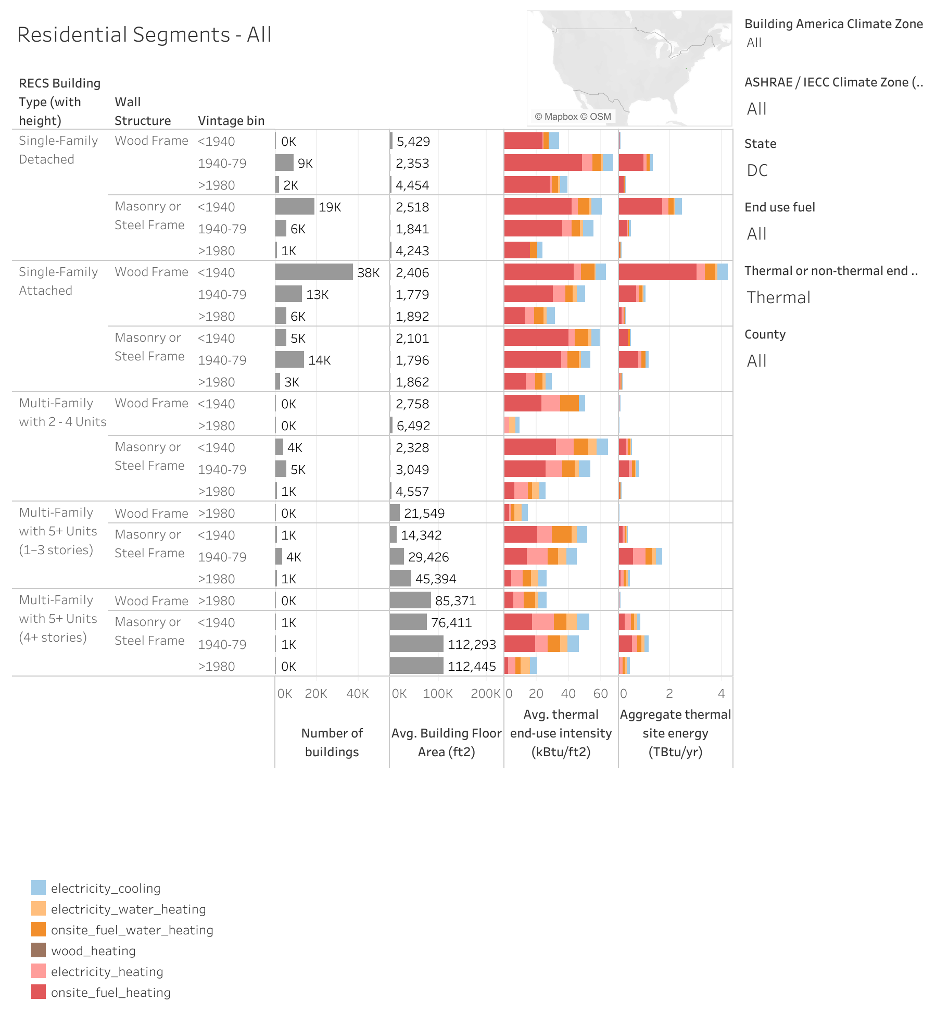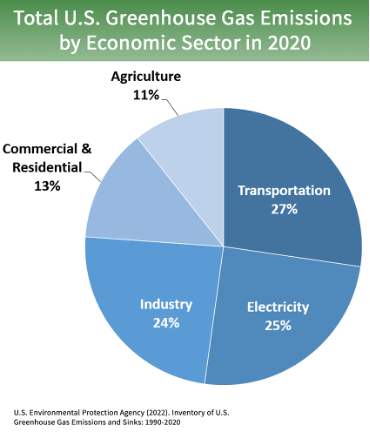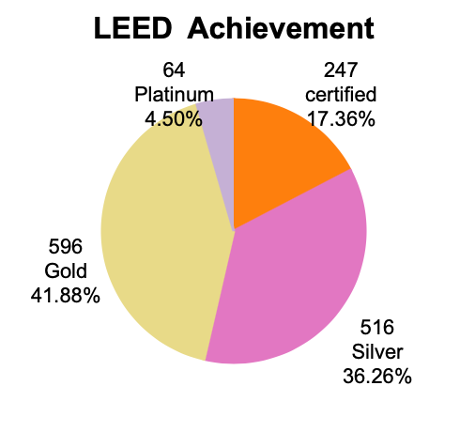At Issue D.C. - The Inherent Efficiency of Multifamily Housing
The Inherent Efficiency of Multifamily Housing
The past few years in the District have seen the adoption of numerous laws and regulations aimed at reducing the city’s carbon footprint and increasing energy efficiency. In pursuing cleaner, greener and more efficient use of energy, many of these policies and initiatives have focused specifically on the building sector. Buildings are where we humans live, work, and spend the majority of our time. And with the rise of hybrid and telework arrangements post-pandemic, we have seen a corresponding bump in residential energy consumption (roughly 7-8%) as a result.
But more often than not, these policies get it backwards when it comes to enforcing more rigorous standards on higher density residential buildings. These buildings not only serve a critical role in housing our workforce, but they do so in the most efficient manner of any type of housing. Policy approaches which employ escalated standards based on building size fail to recognize the inherent efficiency of multifamily housing and even penalize those households that use the least energy and produce the smallest carbon footprint. This is not to mention the corollary effect that such mandates have on housing affordability and other policy priorities.
Multifamily Housing is Inherently More Efficient Than Other Types of
Housing
Higher density multifamily residential development is far more energy efficient per square foot and per household than other types of housing. The U.S. Department of Energy’s National Renewable Energy Laboratory (NREL) Building Stock Analysis provides a helpful visualization of energy use among building types. 
As depicted above, average thermal end-use intensity shows a stark drop-off as density increases. For example, a newly constructed apartment unit in a high-rise building (defined here as greater than 4 floors) is approximately 82% more efficient than a new-build single-family home. This is consistent with the findings of international studies, which all reach the same conclusion: energy use intensity of both gas and electricity declines as density increases, up to a factor of six.
Facets inherent to their design help apartments realize this efficiency. This includes:
- HVAC equipment sized appropriately to meet building demand versus other types of housing which employ individual HVAC units
- Smaller household footprints, which consume less electricity
- Party walls, which reduce heat loss and gain
In addition, apartment residents generally use less water per unit than single-family homes and the compact form of multifamily housing yields less energy loss in electric and natural gas transmission.
Multifamily Development is Gentler on the Environment than Other
Types of Housing
Multifamily development also tends to be more compact than single-family housing, thereby creating less land disturbance and fewer impervious surfaces. Compact multifamily development can achieve up to a 30% reduction in runoff of pollutants and sediment compared with conventional suburban development. And, by housing more people on less land, multifamily housing further allows for greater preservation of green spaces.
Multifamily Housing Produces a Smaller Overall Carbon Footprint
Multifamily buildings, through their more efficient use of energy, produce a smaller carbon footprint by generating fewer harmful emissions into the atmosphere. But the benefits of high-density housing don’t stop there. Residents of multifamily housing also make extremely efficient use of transportation infrastructure, which represents another major source of greenhouse gas emissions.
Again, some of this is attributable to design elements:
- Multifamily housing developments are often clustered along transportation corridors making various kinds of mass transportation feasible. As a result, multifamily residents tend to drive fewer miles per unit and also tend to use public transportation more than residents of single-family housing.
- The availability of recreational facilities – including fitness centers, pools, and picnic areas – within multifamily communities reduces the need for automobile trips as most residents can walk to these amenities.
This all leads to reduced auto dependency. Apartment residents average one motor vehicle per household, while owner-occupied houses average two vehicles. Even more impressively, apartment households generate 30-40% fewer vehicle trips than single-family homes. Single-family housing generates an average of ten automobile trips per weekday, while apartments generate only seven. High-rise apartments generate even fewer trips, averaging only four trips per day.
The Multifamily Housing Industry Continues to Lead the Way in
Improving Energy Efficiency

The real estate industry has made significant strides to increase energy efficiency and keep greenhouse gas emissions down despite the intensity of use. This is evidenced by the District’s heavy concentration of green buildings. D.C. is perennially ranked in the top 10 by the U.S. Green Building Council (USGBC) for new green building certifications, and 2021 saw the District ranked #1 in the nation, adding 103 new projects at 20.31 million square feet of space. In total, D.C. boasted 1,774 Leadership in Energy and Environmental Design (LEED)-certified buildings, representing 249,054,363 gross square feet of green building space as of 2019. The bulk of those are commercial office properties, but 84 multifamily residential buildings have been LEED-certified in D.C.
D.C. is perennially ranked in the top 10 by the U.S. Green Building Council (USGBC) for new green building certifications, and 2021 saw the District ranked #1 in the nation, adding 103 new projects at 20.31 million square feet of space. In total, D.C. boasted 1,774 Leadership in Energy and Environmental Design (LEED)-certified buildings, representing 249,054,363 gross square feet of green building space as of 2019. The bulk of those are commercial office properties, but 84 multifamily residential buildings have been LEED-certified in D.C.
At Issue is compiled by the Apartment and Office Building Association (AOBA) of Metropolitan Washington, and is intended to help inform our elected decision-makers regarding the issues and policies impacting the commercial and multifamily real estate industry.
AOBA is a non-profit trade organization representing the owners and managers of approximately 185 million square feet of office space and over 400,000 apartment units in the Washington metropolitan area. Of that portfolio, approximately 80 million square feet of commercial office space and 94,000 multifamily residential units are located in the District. Also represented by AOBA are over 200 companies who provide products and services to the real estate industry. AOBA is the local federated chapter of the Building Owners and Managers Association (BOMA) International and the National Apartment Association. Along with input provided by AOBA member companies, the following data sources and references were used in compiling the attached report:
- Stephen Evans, D. Godoy-Shimizu, D. Humphrey, Philip Steadman, Paul Ruyssevelt, and Rob Liddiard, University College of London. Urban Density and Energy Efficiency in the London Building Stock Model. Energy Evaluation Europe 2020 Conference – Volume 2020. July, 2020.
- Philipp Rode, Christian Keim, Guido Robazza, and Pablo Viejo. Cities and Energy: Urban Morphology and Residential Heat-Energy Demand. Environment and Planning B: Planning and Design: Volume 41. February, 2014.
- Janet Reyna, Eric Wilson, Aven Satre-Meloy, Amy Egerter, Carlo Bianchi, Marlena Praprost, Andrew Speake, Lixi Liu, Andrew Parker, Ry Horsey, and Stacey Rothgeb. U.S. Building Stock Characterization Study – A National Typology for Decarbonizing U.S. Buildings, Part 1: Residential Buildings. December, 2021.
- U.S. Building Typology Segmentation Residential Building Stock Analysis. U.S. Department of Energy National Renewable Energy Laboratory. May 3, 2022 Update.
- The Costs and Benefits of Alternative Growth Patterns: The Impact Assessment of the New Jersey State Plan. Center for Urban Policy Research, Rutgers University. September, 2000.
- U.S. Census American Housing Survey. U.S. Census Bureau.
- Volume 1 of 3. Institute of Traffic Engineers. December, 1997.
- The Case for Multifamily Housing, 2nd Edition. The Urban Land Institute. 2003.
- Creating Successful Communities; A New Housing Paradigm. National Multihousing Council and the National Apartment Association.
- Total U.S. Greenhouse Gas Emissions by Economic Sector in 2020. United States Environmental Protection Agency.
- Deisy Verdinez. USGBC Releases its Top 10 States for LEED, Recognizing Leaders Committed to More Sustainable and Resilient Buildings, Cities and Communities. U.S. Green Building Council. January 26, 2022.
- Heather Benjamin. Infographic: Top 10 States for LEED in 2021. U.S. Green Building Council. January 26, 2022.
- U.S. Green Building Council State Market Brief. 2019.
AOBA strives to be an informational resource to our public sector partners. We welcome your inquiries and feedback. For more information, please contact our Senior Vice President of Government Affairs, Brian Gordon.
